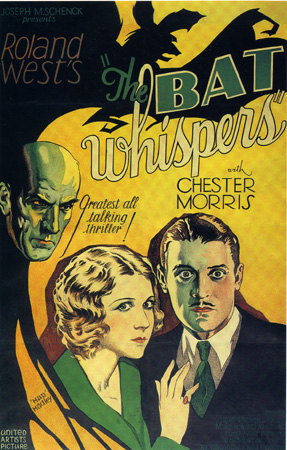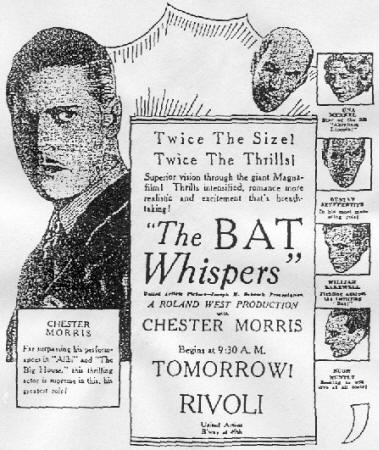"The Bat Whispers" in 65mm |
Read more
at in70mm.com The 70mm Newsletter |
| Written by: Rick Mitchell Film Editor/ Film Director/ Film Historian | Date: 17 November 2005 |
 In 1929 and 1930 11 features, 2 shorts, and some newsreel footage have
been definitely confirmed as being photographed on negatives larger than
35mm with frames wider than 1.33:1. Only two of those features and some of
the newsreel footage survive and have been preserved: Fox's 70mm Grandeur
version "THE BIG TRAIL", preserved as a 35mm anamorphic fine grain, dupe
negative, and print by Ralph Sargent of Film technology; 70mm Grandeur
newsreel footage preserved by Karl Malkames, ASC; and Roland West's 65mm
Magnifilm version of "The Bat Whispers", preserved to a 65mm fine grain by
Bob Gitt of the UCLA Film Archives and YCM Laboratories, with the sound
track upgraded by Film technology, from which a 35mm anamorphic dupe
negative was made, the source of the excellent 35mm anamorphic print shown
recently by the American Cinematheque at the Egyptian Theater. (Scott
MacQueen did a superb article on this restoration for the September, 1988
issue of American Cinematographer; George Turner covered the production of
the 1930 versions and earlier 1926 silent version in the March, 1986
issue; the 1959 Allied Artists remake starring Vincent Price and Agnes
Moorehead seems to have been forgotten though its theme song was a novelty
hit at the time.) In 1929 and 1930 11 features, 2 shorts, and some newsreel footage have
been definitely confirmed as being photographed on negatives larger than
35mm with frames wider than 1.33:1. Only two of those features and some of
the newsreel footage survive and have been preserved: Fox's 70mm Grandeur
version "THE BIG TRAIL", preserved as a 35mm anamorphic fine grain, dupe
negative, and print by Ralph Sargent of Film technology; 70mm Grandeur
newsreel footage preserved by Karl Malkames, ASC; and Roland West's 65mm
Magnifilm version of "The Bat Whispers", preserved to a 65mm fine grain by
Bob Gitt of the UCLA Film Archives and YCM Laboratories, with the sound
track upgraded by Film technology, from which a 35mm anamorphic dupe
negative was made, the source of the excellent 35mm anamorphic print shown
recently by the American Cinematheque at the Egyptian Theater. (Scott
MacQueen did a superb article on this restoration for the September, 1988
issue of American Cinematographer; George Turner covered the production of
the 1930 versions and earlier 1926 silent version in the March, 1986
issue; the 1959 Allied Artists remake starring Vincent Price and Agnes
Moorehead seems to have been forgotten though its theme song was a novelty
hit at the time.)As you know, I have spent the last year researching the poorly documented history of commercial theatrical Wide Screen before 1952 and there are mysteries surrounding "The Bat Whispers" that are far more complex than that in the film itself. That the original 65mm negative, separate soundtrack, and other elements survived in apparently very good condition in the vaults of the Mary Pickford Foundation is both a mystery and a miracle. It was possible to make a safety 65mm fine grain from that negative because both its perforation and frame dimensions were exactly the same as that introduced with Todd-AO in 1953. (Thomas Hauerslev's recently published interview with Walter Siegmund, one of the developers of Todd-AO, confirms that format was chosen because they were provided with 65mm cameras from 1930 for test purposes; you can find this interview on in70mm.com., though I don't have the specific link at this time. These cameras, and 70mm Grandeur cameras modified for 65mm, were later used not only on "OKLAHOMA!", "AROUND THE WORLD IN 80 DAYS", "SOUTH PACIFIC", and "THE ALAMO", but also on "RAINTREE COUNTY".) The biggest mystery is what kind of camera was used to photograph "The Bat Whispers". At the time of its production, there was a battle going on over 70mm, promoted by William Fox, versus 65mm being promoted by Paramount, Warner Bros., and notably Capt. Ralph G. Fear. (Why the battle over a silly 5mm is also still pretty much a mystery as they weren't using it for the sound track, which would be the case with Todd-AO, but I'm saving all that for my book.) The 70mm cameras were being built primarily by Mitchell Camera (no relation, of course), which was then personally owned by William Fox, and a couple of outside subvendors like Stein Camera. In the Spring of 1930, Fear introduced his combination 65-35 camera and made several trade announcements that it was being used on an unnamed major film by an equally unnamed major company. Since no verification has been found of any 1930 65mm production being shot with Fear's camera, it's long been assumed that it was used on "The Bat Whispers", the wide film version of which was advertised as being in Magnifilm, the first frame filling thing you see on the film. (This very name has caused some confusion with Paramount's earlier aborted 56mm Magnafilm, so named to capitalize on its Magnascope "enlarged screen" technique.) |
Further
in 70mm reading: The Bat Whispers Magnified Grandeur Early Large Format Internet link: |
 "The
Bat Whispers" (UA 1930) was the only film ever shown in MAGNIFILM. (This NYC
advertisement misspells it 'MAGNAFILM'). It was shot on 5-perf. 65mm film
and Standard 35mm. "The
Bat Whispers" (UA 1930) was the only film ever shown in MAGNIFILM. (This NYC
advertisement misspells it 'MAGNAFILM'). It was shot on 5-perf. 65mm film
and Standard 35mm.However, in the course of preparing an American Cinematographer article on "The Bat Whispers" and its earlier silent version, THE BAT (1926), the late historian George Turner learned from Stanley Cortez, ASC, who had been the assistant cameraman on "The Bat Whispers", that the camera, which director Roland West had purchased personally, had come from George K. Spoor in Chicago, leading to speculation that it might have been manufactured for the wide film Spoor and his technician partner P. John Berggren had reportedly been working on for 15 years and had been licensed by RKO after a demonstration the previous year. Though this process had previously used a 63.5mm negative, there had been a number of press announcements that RKO was having them switch to 65mm to conform to what the other studios were doing, however there is no evidence that this was actually done and surviving frame blowups from the only feature shot in a revised version of Spoor-Berggen*, "DANGER LIGHTS", work out to 63.5mm, according to Daniel J. Sherlock, who did those measurements. It had been my conclusion that the camera West bought was one that had been sent to Spoor and Berggren for possible study with regard to making the conversion to 65mm, but I've since learned that Mitchell had modified at least one 70mm camera for 65mm, so it could have been that camera went to Spoor and was returned to West. (Now you may understand why this research has taken over a year and I still haven't gotten to the Sponable papers at Columbia University in New York!) But what about 65mm version of "The Bat Whispers" itself? While the restoration of "The Bat Whispers" got a fair amount of coverage and study twenty years ago, there has been virtually no commentary on "The Bat Whispers". George Turner, who had apparently never seen the wide film version, dismissed it as a photographed play done in full shots from the equivalent of front row center, an opinion based on production stills. Today, "The Bat Whispers" does seem an odd choice for a large, wide film/screen production, but one has to look at the situation in early 1930, primarily with regard to sound. While the initial Spoor-Berggren, Paramount Magnafilm, and Fox Grandeur presentations had all included silent shots of Niagara Falls and an historical silent film called "THE AMERICAN" may have been shot in an earlier version of Spoor-Berggren (this film was never released and may not have been finished), the initial demonstrations of these processes occurred after the popularity of sound had been established, and indeed was probably the encouragement for these developments. The first, Spoor-Berggren's, used a musical number from a current stage musical, Lady Fingers, while Fox used a concurrently shot Grandeur version of its "FOX MOVIETONE FOLLIES OF 1929"; Paramount's short "YOU'RE IN THE ARMY NOW" was apparently also primarily a stage bound vaudeville turn. It should be noted that the first outdoor talkie, "IN OLD ARIZONA", was in production at the time these demonstrations were presented, so it was more natural that the initial wide film productions would also be frame filling musical revues of a type that were fast wearing out their welcomes in their 35mm versions, despite the increased use of two-color Technicolor. Five of the last seven Wide Film productions would exploit the great outdoors though they turned out to be "Widies-come-latelies." "The Bat Whispers" is still an anomaly, being a haunted house mystery of the type that was very popular on the stage in the Twenties, like "THE CAT AND THE CANARY", "THE GORILLA", and it's source, a popular play by Mary Rinehart Roberts. Yet, despite his own origins in the theater, West had a unique understanding of cinematic technique which he applied to all of his few films, including the unique challenges of dealing with the wide frame. The first reel or so, documenting the activities of the master criminal known as "The Bat" is pure silent cinema, making extensive use of light and shadow, intricate miniatures and trick shots (some blown up from the concurrently shot 35mm version), and swooping crane shots and camera movements that put today's attempts to do the same thing through CGI to shame. After that, the action is centered in an isolated country estate during an on-and-off thunderstorm, the standard setting for such plays, yet West and his cinematographers Ray June, ASC and Robert H. Planck, ASC, who supervised the 65mm version, make great use of cinematic space to heighten the atmosphere and suspense in a way that could serve as a real lesson to today's filmmakers so obsessed with "claustrophobic cinema" even in Wide Screen projects. West makes Paul Roe Crowley's huge looking and uniquely Twenties baroque sets an integral part of the telling of his tale. I saw a 16mm print of the 35mm version a couple of years ago, not recently enough to really be able to make a comparison, but it was quite interesting to see how the extra space on the sides, even when the main characters were centered, enhanced the sense of visceral involvement with the scene. I believe the staging of a number of scenes was also different, better balancing the overall composition for the wide film version, but not self-consciously so. The Wide Film version appears to have been shot entirely with a 50mm lens, with the possible exception of some inserts, closeups, and some of the miniature shots. There are a few shots that are soft in focus, but most of the film is incredibly razor sharp, a tribute not only to the original cinematographers, but also the preservationists. If you get another chance to see this, or "THE BIG TRAIL", on the BIG screen, don't miss it. *NOTE: Although the Spoor-Berggren process has generally been called "Natural Vision", I've found no association of this name with this process until publicity releases for "DANGER LIGHTS" in November, 1930. In fact, there were two other companies calling themselves "Natural Vision Pictures" using a variation of an unsuccessful process called WideScope, in 1926 and earlier in 1930. |
|
|
Go: back
- top -
back issues
- news index Updated 21-01-24 |
|
